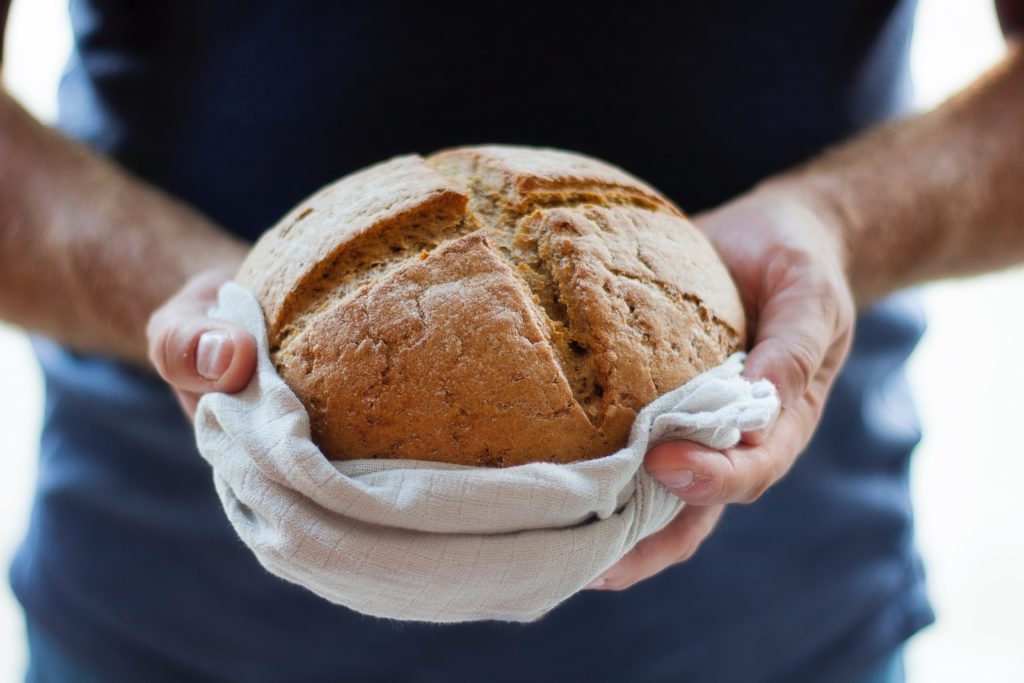All fields are required
Posted in Food Safety on February 6, 2019

Baking bread is a pure joy. Like so many things you can do in your kitchen, it’s basically chemistry, but it feels like alchemy. Add a bit of yeast in warm water to salt and flour, and poof: not only do you get dough, but the dough changes – it expands outwards, swelling with bubbles of gas. Like those small foam dinosaurs that grow in water, it seems to take on larger proportions by magic. Here’s what you need to know about bread bacteria.
That growth is thanks to yeast, which are among the simplest and most useful of living things. They’re responsible for all kinds of fermented foods and beverages, including beer, wine, and cheese. The gases that they respire out are the force that leavens the bread. Through their collective exhalation, a kind of miracle is performed; you can see the loaves multiply right before your eyes.
Yeast is also one of the classes of microbe that live on and around us. It’s present in our digestive tracts, our throats, and other parts of our bodies as well. Our cells are likely outnumbered by the total populations of the tiny cellular ecosystems that we carry around with us — all those flora and fauna. Sometimes, their numbers get really out of hand, as anyone who’s suffered through thrush before can tell you.
For the most part, however, yeast works with us, rather than against it. Given this, it should come as no surprise that bakers have a special relationship with yeast and other bread-related microbes. A passage from a recently published book that landed a spotlight on NPR’s website describes just such an experiment.
The book is called Never Home Alone, by Rob Dunn, and it’s a jubilant celebration of the microbial life that we share spaces with in the vein of Wild Fermentation by Sandor Katz or The Omnivore’s Dilemma by Michael Pollan. Never Home Alone is all about the bacteria that are in and around us, and the manifold ways in which they shape our world. It’s a joyous book, one that really believes that our lives are enriched by sharing spaces with these tiny neighbors of ours, and it makes a passionate case for the importance of bacteria.
Here’s how the experiment in question was set up: fourteen bakers from fifteen countries were to make the same sourdough from the same batch of starter. They themselves, and the particular conditions of their home kitchens, would be the variables in the experiment. The goal was to measure the particular microbial fingerprint that the bakers had, and whether that microbial fingerprint could be seen on their hands, in the dough that they worked, in their kitchen, or in the bread that they produced.
The ingredients for sourdough starter were shipped out to the fifteen bakers, who were instructed to use them to make the starter, feeding it flour and attending to it until it was time for the second phase of the experiment. The starters and bakers were brought to a single location; the starter was swabbed, as were the hands of the bakers, and they were instructed to make the starter into bread. That bread was also swabbed, and the various samples were shipped off so that the bacteria therein could be counted and typed genetically.
The experiment revealed that the things we do with our hands greatly influences the bacteria who are living there. We all carry with us a “sheath” of bacteria that lives on our skin. These bacteria are particular to us, and they’re well established; when we wash our hands, Dunn points out, we don’t actually get rid of anything except for any pathogenic bacteria that are new arrivals and thus not yet properly established. Other, more rooted populations of bacteria are as much a feature of our hands as the skin that they live on.
Because the bakers bake, their hands have mostly baking microbes on them. Dunn and his team expected to see something like this, but in his description of the passage, you get a real sense of awe, almost wonder: “The first surprise was that the bakers’ hands were totally different from any hands we had ever seen before. On average, 25 percent and up to 80 percent of all of the bacteria on the hands of the bakers were Lactobacillus and related species. Similarly, nearly all of the fungi on the bakers’ hands were yeasts that can be found in sourdough starters, such as species of Saccharomyces. We had no idea this was even possible, and we don’t yet fully understand it.”
Dunn speculates that the robust microbial community they found might lend the bakers some degree of protection from the vagaries of microbes: “a community of microbes might make the bakers less likely to get sick than are other people. I’m speculating, but this result is really very novel and leads us down many new paths. I wonder whether all people who work with food develop unusual hand microbes. I wonder whether when more people cooked, a hundred years ago, or five thousand years ago, the continuity between food and hand microbes wasn’t much greater in general than it is today. I wonder many things. We will have to do more experiments. And this wasn’t the only exciting result.”
A deeper understanding of the role that bacteria play in our lives and in our kitchens might well reveal to us new and novel techniques for cooking. They might also help us to chart the particular strengths and weaknesses of our immune systems. There’s a lot of possibilities. This writer is mostly excited to have another excuse to bake bread, which he already spends too much time doing.
By: Sean McNulty, Contributing Writer (Non-Lawyer)